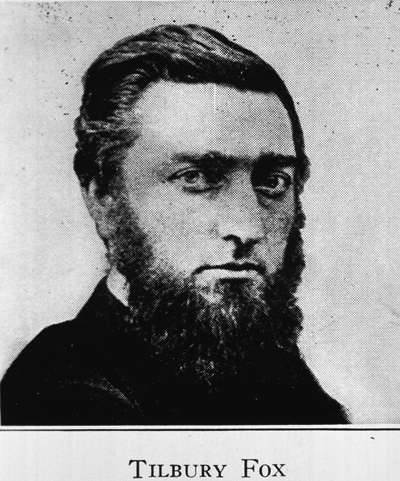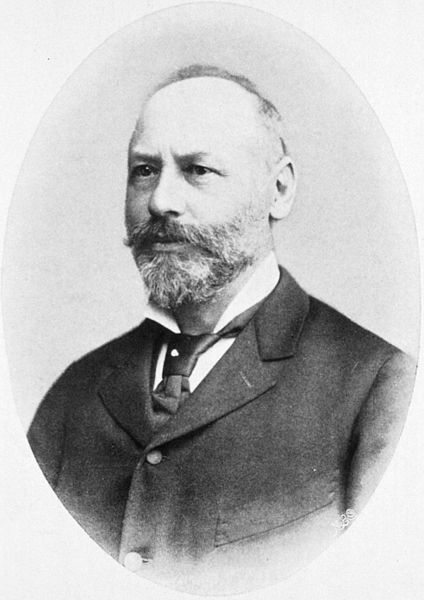<Back to Index>
- Dermatologist William Tilbury Fox, 1836
- Dermatologist Moritz Kaposi, 1837
PAGE SPONSOR

William Tilbury Fox, MD, FRCP (1836 – 7 June 1879) was an English dermatologist.
He was born in Broughton, Hampshire, the son of physician Luther Owen Fox and Mary (née Tilbury) Fox, and the brother of Thomas Colcott Fox, also a dermatologist. From 1853 Tilbury Fox attended the University College Hospital medical school. He graduated in 1857 and received his MD in 1858. His first job was at University College Hospital as house physician to Sir William Jenner who was in charge of the dermatology department. He later took jobs at the General Lying - in Hospital in Lambeth and at a general practice. He decided to specialize in obstetrics and took the position of physician - accoucheur at the Farringdon General Dispensary. He was also a senior physician at St John's Hospital for Skin Diseases. In 1863 he published Skin Diseases of Parasitic Origin, in which he was the first physician in the UK to create a thorough study of the pathology and causes of dermatophytosis (ringworm). At this time, he decided to specialize in dermatology rather than obstetrics.
In 1864, Fox developed an interest in tropical dermatology with a trip to India with the Earl of Hopetoun. As a result of this trip he published Scheme for obtaining a better knowledge of endemic skin diseases in India, prepared with T. Farquhar, for the India Office in 1872. In 1866, he took the position of physician to the skin department at Charing Cross Hospital and in 1868 he became the physician in charge of the dermatology department back at University College Hospital.
In the 1870s, Henry Radcliffe Crocker came to the University College Hospital and worked under Fox in the dermatology department. At this time, the practice of specializing in medicine was frowned upon in the United Kingdom (although more popular in continental Europe), but Fox and Crocker were credited with bringing some structure to the field of dermatology. Fox wrote extensively on the subject and in 1875, he published a revised version of Atlas of Skin Diseases by Robert Willan. He also had an editorial position at The Lancet.
William Tilbury Fox died of an aortic condition on 7 June
1879 in Paris, France, at the age of 43.
He was survived by his wife Sophia Campbell Fox and was
buried at Willesden cemetery in London.

Moritz Kaposi (Hungarian: Kaposi Mór) (born 23 October 1837 in Kaposvár, Hungary – 6 March 1902 in Vienna, Austria) was a Hungarian physician and dermatologist who discovered the skin tumor that received his name (Kaposi's sarcoma).
Born to a Jewish family, originally his surname was Cohen; but, with his conversion to the Catholic faith, he changed it to Kaposi in 1871, in reference to his town of birth. One purported reason behind this is that he wanted to marry a daughter of current dermatology chairman, Ferdinand Ritter von Hebra, and advance in the society, which he could not have done being of Jewish faith. This seems unlikely because he married Martha Hebra and converted to Catholicism several years prior to changing his name, by which time he was already well established in the Vienna University faculty and a close associate of von Hebra. A more plausible explanation is based on his own comments to colleagues that he changed his name to avoid confusion with five other similarly named physicians on the Vienna faculty. Rumors about the sincerity of both his marriage and his concerns about his Jewish ancestry may have arisen through professional jealousy (William Dubreuilh (1857 – 1935), first professor and chairman of dermatology in Bordeaux: "On disait de Kaposi qu´il avait pris la fille de Hebra, sa maison, sa chaire et sa clientèle, laissant le reste à son beau - frère Hans Hebra.")
In 1855, Kaposi began to study medicine at the University of Vienna and attained a doctorate in 1861. In his dissertation, titled Dermatologie und Syphilis (1866) he made an important contribution to the field. Kaposi was appointed as professor at the University of Vienna in 1875, and in 1881 he became member of the board of the Vienna General Hospital and director of its clinic of skin diseases.
Together with his mentor, Ferdinand Ritter von Hebra, he
authored the book Lehrbuch der Hautkrankheiten
(Textbook of Skin Diseases) in 1878. Kaposi’s main work,
however, was Pathologie und Therapie der
Hautkrankheiten in Vorlesungen für praktische Ärzte und
Studierende (Pathology and Therapy of the Skin
Diseases in Lectures for Practical Physicians and
Students), published in 1880, which became one of the most
significant books in the history of dermatology, being
translated to several languages. He is credited with the
description of xeroderma pigmentosum, a rare genetic
disorder now known to be caused by defects in nucleotide
excision repair ("Ueber Xeroderma pigmentosum.
Medizinische Jahrbücher, Wien, 1882: 619 – 633"). Among
other diseases, Kaposi was the first to study Lichen scrofolosorum and Lupus
erythematosus. In all, he published over 150 books and
papers. He is widely credited with advancing the use of
pathologic examination in the diagnosis of dermatologic
diseases.
His name entered into the history of medicine in 1872, when he described for the first time Kaposi's sarcoma, a cancer of the skin, which he had discovered in five elderly male patients and which he initially named "idiopathic multiple pigmented sarcoma". More than a century later, the appearance of this disease in young gay men in New York, San Francisco and other coastal cities in the United States was one of the first indications that a new disease, now called AIDS, had appeared. Kaposi's sarcoma is a tumor that is caused by a virus, Kaposi's sarcoma - associated herpesvirus or KSHV, discovered in 1993. Kaposi's sarcoma is now the most commonly reported cancer in parts of sub - Saharan Africa.
According to his biographer, Dr. J.D. Oriel, "in his lifetime, Moritz Kaposi was acknowledged as one of the great masters of the Vienna School of Dermatology, a superb clinician and renowned teacher". While his mentor, Ferdinand von Hebra, is considered the "father of dermatology", Kaposi was one of the first to establish dermatology on its anatomical pathology scientific basis. He became the chairman of Vienna School of Dermatology, after Hebra's death in 1880.